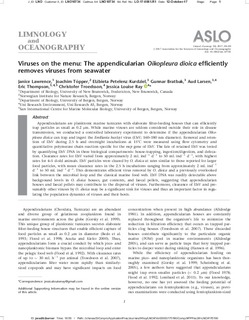Viruses on the menu: The appendicularian Oikopleura dioica efficiently removes viruses from seawater
Lawrence, Janice; Töpper, Joachim Paul; Petelenz-Kurdziel, Elzbieta Anna; Bratbak, Gunnar; Larsen, Aud; Thompson, Eric; Troedsson, Christofer; Ray, Jessica Louise
Journal article, Peer reviewed
Accepted version

Åpne
Permanent lenke
http://hdl.handle.net/11250/2465501Utgivelsesdato
2017Metadata
Vis full innførselSamlinger
- Publikasjoner fra CRIStin - NINA [2397]
- Scientific publications [1423]
Originalversjon
10.1002/lno.10734Sammendrag
Appendicularians are planktonic marine tunicates with elaborate filter-feeding houses that can efficiently trap particles as small as 0.2 lm. While marine viruses are seldom considered outside their role in disease transmission, we conducted a controlled laboratory experiment to determine if the appendicularian Oikopleura dioica can trap and ingest the Emiliania huxleyi virus (EhV; 160–180 nm diameter). Removal and retention of EhV during 2.5 h and overnight incubations at 158C were measured using flow cytometry and quantitative polymerase chain reaction specific for the mcp gene of EhV. The fate of retained EhV was tested by quantifying EhV DNA in three biological compartments: house-trapping, ingestion/digestion, and defecation. Clearance rates for EhV varied from approximately 2 mL ind21 d21 to 50 mL ind21 d21, with highest rates for 4–5 d-old animals. EhV particles were cleared by O. dioica at rates similar to those reported for larger food particles, with mean clearance rates in the 2.5 h incubations ranging from approximately 2 mL ind21 d21 to 50 mL ind21 d21. This demonstrates efficient virus removal by O. dioica and a previously overlooked link between the microbial loop and the classical marine food web. EhV DNA was readily detectable above background levels in O. dioica houses, gut contents, and faecal pellets, suggesting that appendicularian houses and faecal pellets may contribute to the dispersal of viruses. Furthermore, clearance of EhV and presumably other viruses by O. dioica may be a significant sink for viruses and thus an important factor in regulating the population dynamics of viruses and their hosts.